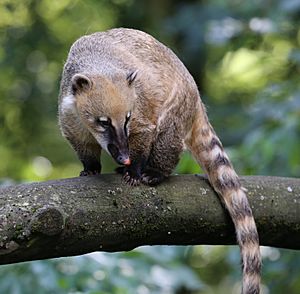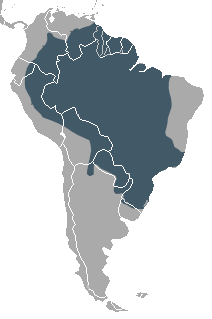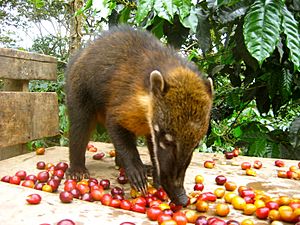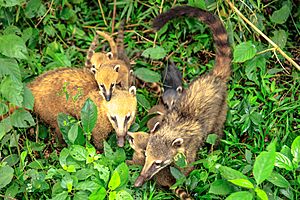South American coati facts for kids
Quick facts for kids South American coati |
|
|---|---|
 |
|
| Conservation status | |
| Scientific classification | |
| Genus: |
Nasua
|
| Species: |
nasua
|
| Subspecies | |
|
13, see text |
|
 |
|
| South American coati range. Note: Also found in west Ecuador, and west and north Colombia, see text. | |
| Synonyms | |
|
Viverra nasua Linnaeus, 1766 |
|
The South American coati (Nasua nasua), also known as the ring-tailed coati, is a type of coati. It is part of the raccoon family (Procyonidae). You can find them in warm, tropical and subtropical parts of South America.
An adult coati usually weighs about 2 to 7.2 kilograms (4.4 to 15.9 pounds). They are about 85 to 113 centimeters (33 to 44 inches) long. Half of their length is their long tail! Their fur color can be very different, and the rings on their tail might be hard to see. A key way to tell them apart from their northern cousin, the white-nosed coati, is that they don't have a mostly white nose.
Contents
Where South American Coatis Live
The South American coati lives in many places across tropical and subtropical South America. They are found in forests east of the Andes mountains. They can live as high as 2,500 meters (8,200 feet) up! Their home stretches from Colombia and The Guianas all the way south to Uruguay and northern Argentina.
Coatis are more likely to live in places with lots of forest cover. They are less likely to be found in very high places. They have been seen in western Ecuador and northern and western Colombia. In Argentina, they live in Santa Fe and Salta Provinces.
Another type of coati, the mountain coati, mostly lives in higher places than the South American coati. However, sometimes their homes overlap. South American coatis have also been brought to the island of Mallorca. There, they are considered an invasive species, meaning they are not native and can harm the local environment.
Coatis as Invasive Species
In Europe, the South American coati is on a special list. It's called the "Invasive Alien Species of Union concern." This means that since 2016, people in the European Union are not allowed to bring these animals in, breed them, move them, sell them, or let them go into nature on purpose. This rule helps protect the local plants and animals.
How South American Coatis Behave

South American coatis are diurnal animals. This means they are active during the day. They live both on the ground and in trees. They are omnivorous, which means they eat both plants and animals. They mostly eat fruit, insects, other small animals, and bird eggs.
They look for fruit in trees, even high up in the branches. They use their long snouts to poke into small spaces to find prey on the ground. They also flip over rocks or tear open logs with their strong claws to find food.
Female coatis usually live in large groups called "bands." These bands can have 15 to 30 animals! Male coatis, however, usually live alone. When people first studied coatis, they thought these solitary males were a different species. They even called them "coatimundis," a name still sometimes used today. Neither the female bands nor the solitary males protect a specific area. This means their territories can overlap.
Coatis in a group make soft whining sounds to talk to each other. But if there's danger, they make loud "woofs" and "clicks" as alarm calls. Coatis usually sleep in trees. If they hear an alarm call, they climb higher into the trees. Then, they might drop to the ground and run away to escape. Some animals that hunt South American coatis include foxes, jaguars, jaguarundis, and sometimes even humans.
Reproduction and Life Cycle

When fruit is plentiful, all the female coatis in a group become ready to have babies at the same time. They will mate with several males. The babies grow inside the mother for about 74 to 77 days.
Female coatis give birth to 1 to 7 young at a time. In the wild, a mother coati will leave her group to have her babies. She builds a nest in a tree for them. About 5 to 6 weeks later, she brings her young back to the group. Young females usually stay with the group they were born into. Young males, however, usually leave their birth group when they are about three years old.
South American coatis typically live for up to 7 years in the wild. But if they live in captivity, like in a zoo, they can live much longer, up to 14 years!
About Their Scientific Names
The scientific name Viverra nasua was first given to a red coati in 1766 by Carl Linnaeus. Later, it was placed in the genus Nasua. Scientists recognize that there are 13 different types, or subspecies, of the South American coati.
Images for kids
See also
 In Spanish: Coatí de cola anillada para niños
In Spanish: Coatí de cola anillada para niños




